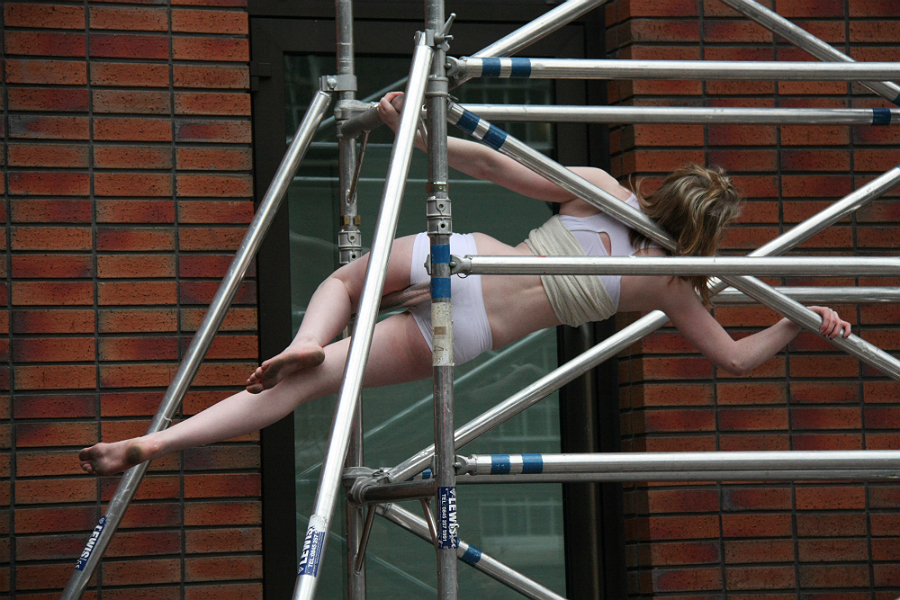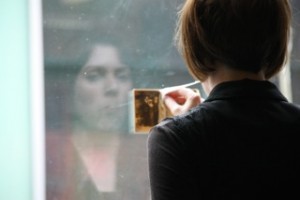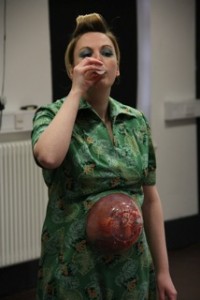‘Poolside Emergency – Reviewed

Last week C James Fagan went to greet an old friend at the Bluecoat. He hoped they’d still get on…
Ever found yourself in a situation where you’re about to meet an old friend, one that you haven’t seen in a long time? As the meeting approaches, you begin to wonder if you’ll still get along; will that elusive connection that glued you together still be there? Or has it been replaced by an awkward silence?
In part this is how I feel about the return to the Bluecoat of the live art free-for-all that is ‘Poolside Emergency, whose absence last year was noted. Considering previous ‘poolsides have featured dead pigs, butter being pushed in new ways, lift dancing and knitted asteroids, I have hopes that this reunion will be pleasant at least.
I arrive at the Bluecoat to see the mechanism of staff, volunteers and performance being put in to place. I grab a programme and face my first issue: orientation, trying to formulate a plan, a path through to get the most out of the day’s offerings. The day could be defined by what I miss as much as I see.
I head up to the performance space to see Kitty Graham’s The Bare Earth. It’s a piece I’ve seen before, and doesn’t seem to have greatly changed – Graham emerges from her bed of earth; she unearths some deep animal fears of the things in the unknowable darkness. I come across an empty and unguarded sign-up sheet and promptly scrawl my name on it.
Next I stumble across Rachel Gomme’s Handover, a small quiet piece sat in the corner of the Bluecoats Bistro. The concept is simple: to leave a mark, touch something, the piece involves having my palm inked and then pressing it against Rachel’s hand, both leaving an inky print on the handkerchief in-between. I get to keep the hanki (and a blue palm for the rest of day). It’s a brief piece, one that gets its point across clearly; that point being the indelible marks left by encounters.
I check the sign-up sheet to see what I’ve signed up for: Xristina Penna’s aswespeakproject. I’m greeted by a woman holding a clipboard, who introduces herself then leads me to a room at the end of a corridor. There awaits two people in overalls; once introduced they disappear behind a screen splitting the room in two. It’s quite clinical, in a fine art way, I’m becoming part of a process here, one involving surrendering an item of clothing. Returning to the other side, an image of my jumper is projected on the screen. I’m quizzed about said jumper. I realise that there’s nothing very special about the jumper.
What meagre information I can provide makes up the data for an impromptu dance. This information is being transformed in a way I don’t really understand. I know I have been processed/become part of some collective, whereby contributing to something bigger then myself.
Having had my data gathered, I’m free to attend another appointment. This time at a shed which currently is home to PGB, who when my time comes I discover consists of two girls. In this shed they have set up a stock exchange dealing in secrets. They get me to give up a secret (nothing hardcore) and give some in exchange. The punchline in this likeable, breezy piece is that once a secret is known it loses its value. Not exactly revelatory, but the performers provide a certain amount of charm.
I take in Frances-Kay’s Scaffold. Moving in-between the pieces of scaffolding she appears to be at once exposed and protected by the metal framework she inhabits. I chat with information assistants who want to see what’s going on and yet are duty bound to miss it. At this point my mind is not unlike my bag, randomly stuffed with things gained from what I’ve seen.
From this mess I pull out the programme, attempting to mentally arrange a running order. I drop into two durational pieces. The first being Paper People Theatre’s piece, Here We Remain. A trio form a tableau – each character held in a moment of waiting, working through some kind of ritual, creating a sense of delicacy.
The second durational piece is Lindsay Bennett’s Inverted Grey. You’re hit by the smell of talc and a strange faded glamour; there is a chanteuse signing If you went away. Between us, there is a picture frame suspended in mid-air, in front of which is a special viewing area marked out for me. I stand there as she disrobes and crosses the talc-covered floor, applying more to herself and the portrait on the wall. There is a sense of loss in this piece, of being witness to, and somehow complicit in one person’s decay.

Being only a voyeur I leave, arriving at Sarah Grainger-Jones. She stands with her back to us, facing the window, on which there is an old postcard featuring a line of people. Grainger-Jones proceeds to take gum from her mouth and stretch it to the postcard. It occurs to me that I’m watching an attempt of Grainger-Jones to stretch a mediumistic connection between herself and the people in the picture, only to discover that this action only serves to create more distance, hiding the figures under layers of gum and saliva.
It’s back up the stairs now for Moreno Solinas’s URANUS, a piece I’m familiar with. Seeing it within the Bluecoat’s performance space provides the performance with a sense of vulnerability. This humorous piece has themes of intimacy, emphasised by being in this traditional arena. When Solinas crawls through the audience it feels plaintive, as if pleading for contact.
Leaving, I wander out on the balcony, where there is a glamorous happening. A fittingly glamorous lady, Sophia Nathan, is giving a speech. It’s a knowing piece which targets the ‘starfucking’ elements of the art world.
Alas, I have another appointment, one with Rebekka Platt. Amidst the space of the old stairwell it’s easy for me to make associations between her movements and ideas of haunting and possession. Not in a Hammer Horror way but something that touches on memories of movement through spaces.
Back out in the gardens I discover two separate performances underway. One is Inlightless by Michelle Man & Lauren McGowan, featuring a dancer dancing around us in a way that makes me feel like I’m not there, as if the dance is with some projected image of the memories of the place rather than its current physical occupants.
The dance continuing, I step into the makeshift office of David Bethell. Again I get a sense of being a ghost-like figure. Bethell goes about his task of constructing, reproducing, a Constable landscape using the elements of this office. There is a poetry about it: a story of one man transforming his landscape into something beautiful through the most mundane of materials.
I leave Bethell to his task and head towards a pair of durational pieces. One is evocatively entitled Humiliation Piece (for the duration); on entering the space housing this piece I am instructed to read instructions scrolling across a TV screen. Beyond this is Louise Orwin, and as this is her birthday, she’s in her prettiest dress. The rules are simple: we must entice Louise into dare, using objects placed around the stage, which include various food stuffs, beloved personal items and objects of a devious nature. This is a live art trope and it tests and reflects the nature of the audience as much as the performer. In this case there’s a good-natured feel to proceedings rather than a view into the dark souls of the viewers.
Before things can get freaky I have to head for the Citizen Exchange Bureau, an organisation set up by Lara Haworth and Lucy Hayhoe, which deals with the exchange of ideas and knowledge. This being the information age, and knowledge being power, it seems right that data should flow freely to one and all. Though as I am given my knowledge (pertaining to the care of male dogs), I realise that information is useless if I don’t need it/don’t know how to use it. No one is going to find my second hand trivia about Blade Runner any use. But, I get a clear sense of sincerity, that CEB is doing something positive.

Next destination is Julieann O’Malley’s Salty Milk: The Expectation of Violation. This piece has gained some infamy (and has been reviewed here). Entering the space I see the figure of O’Malley hunched over in a polyester dress, franticly scrubbing a single space on the floor. Rising from this spot, I see she has an artificial womb made from a Tupperware bowl and stuff sticking out of her dress – I’m a little distracted by this, it reminds of something the Flaming Lips might do.
But I’m struck by the belligerence of the piece – every time O’Malley takes a shot of salty milk she directly eyeballs the audience. This serves to make us complicit and responsible for the results of ingesting this liquid. For me this is the core of the performance: O’Malley confronts us with our desire to see her eject this saline solution from her body as a form of spectacle.
I duck out for a final visit to the performance space, to see the Façade Theatre. They are here to break up with Dave; the trio each go through the motions, listing the reasons for the termination of their romances. This is a piece whose playfulness may distract from its possible themes of the universality of experience, of how our individual experiences can be modularly transposed to someone else. Either way, I enjoy its lightness and gracefulness.
Dave dumped, I return to the site of Salt Milk to see the splattered aftermath of the piece. A sense of calm pervades the space like the quiet after a row. I slip into the climax of Louise Orwin’s piece as she examines the activities of the last few hours and gives out cake; Orwin seems quite positive, though that may just be Stockholm Syndrome kicking in.
This half-marathon is now over. A breathless experience, I feel like I’ve seen a year’s worth of performance compacted into a single afternoon; plenty bang for your buck. If a little punch drunk, there were points where I felt an extra hour might have enabled me to take in what I had experienced before diving headlong into the next piece – a minor quibble. The works were distinctive enough for them to exist so closely together, even when sharing themes (as with Humiliation Piece and Salty Milk) they complemented each other.
I left satisfied with my Live Art binge; certainly feeling it lived up to its copy of presenting something that swings from beautiful to strange to disturbing. ‘Poolside again shows how well the immediacy of live art can be used to create a sense of vibrancy. I’ve been happy to pig out and hope to have more to chew on in the future.
C James Fagan





